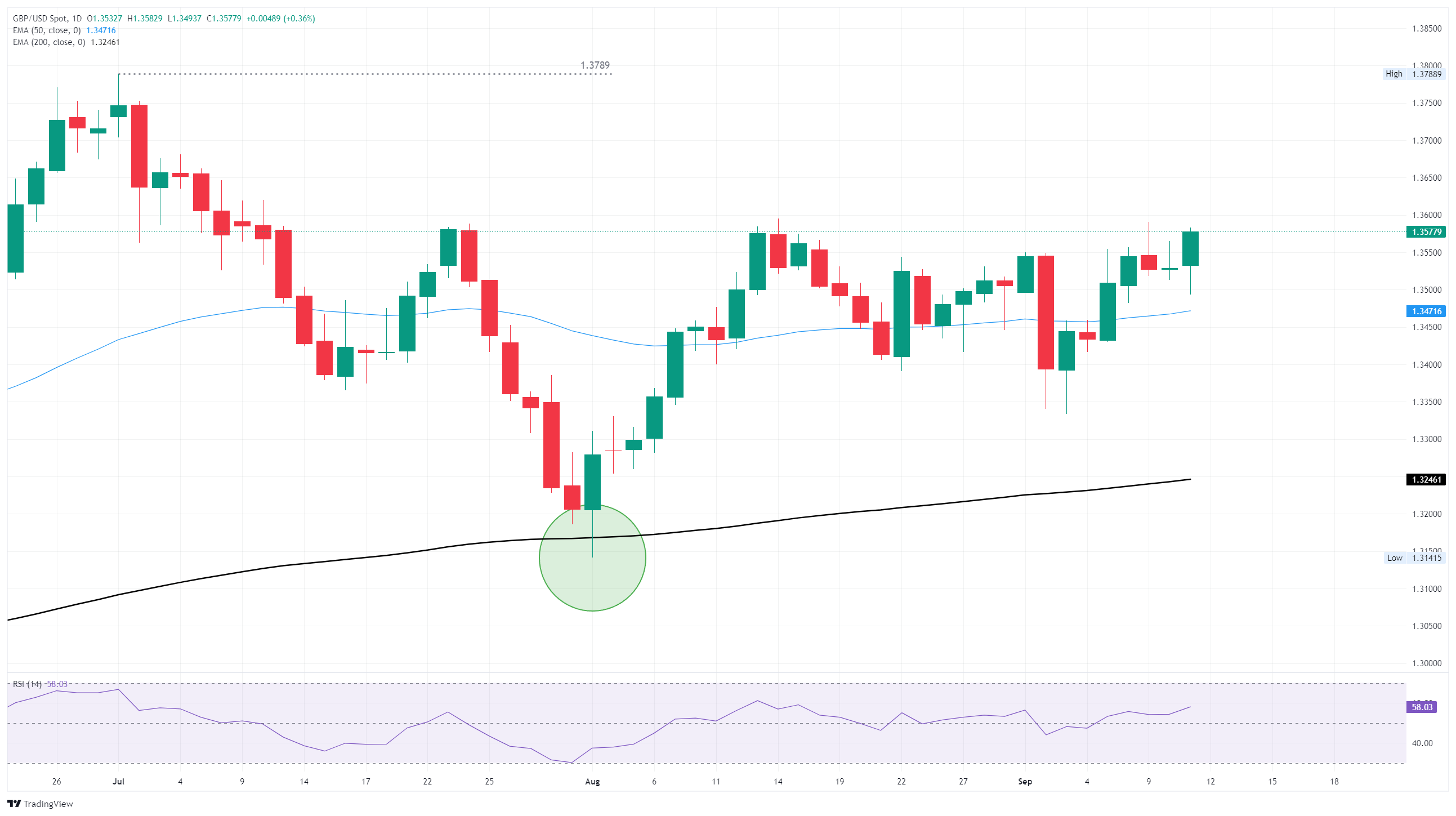GBP/USD catches fresh bids on renewed US Dollar selling pressure

- GBP/USD rose on Thursday, climbing as US Dollar flows reverse course.
- US CPI inflation rose in August, but the Fed is still barreling toward a September rate cut.
- The BoE is also racing toward a rate call next week, but UK rate cut odds are declining.
GBP/USD rallied over one-third of one percent on Thursday, bolstered by fresh US Dollar (USD) weakness as investors pile into bets that the Federal Reserve (Fed) will finally be pushed into a series of interest rate cuts through the rest of the year. Global markets are pivoting into waiting for next week’s Fed rate call, slated for September 17, with a Bank of England (BoE) rate call right behind the Fed that is unlikely to draw nearly as much attention.
Headline US CPI inflation rose again in August, with the annualized index rising to 2.9% and the monthly number accelerating to 0.4% as front-end inflationary pressure continues to build. Shelter and food prices were the largest drivers of near-term inflationary pressure, with the grocery items index rising 0.5% over a single month. Core CPI inflation, or headline inflation less energy and food prices, rose to 2.9% YoY, landing within median market forecasts.
Fed rate cut is pulling all market attention, and dragging down the Greenback
Despite another rise in key inflation pressure, August’s CPI inflation data wasn’t enough to derail market expectations for a Fed interest rate cut next week. According to the CME’s FedWatch Tool, interest rate futures traders are fully pricing in three rate cuts before the end of the year. A 25-basis-point cut is a foregone conclusion at the Federal Open Market Committee’s (FOMC) interest rate decision on September 17, and rate markets are pricing in nearly 95% odds that the Fed will deliver follow-up rate trims on October 29 and December 10.
University of Michigan (UoM) Consumer Sentiment Index data is due on Friday, but the datapoint is unlikely to result in any meaningful shifts in market sentiment. The aggregated survey index is expected to tick down to 58.0 from 58.2.
GBP/USD daily chart

Pound Sterling FAQs
The Pound Sterling (GBP) is the oldest currency in the world (886 AD) and the official currency of the United Kingdom. It is the fourth most traded unit for foreign exchange (FX) in the world, accounting for 12% of all transactions, averaging $630 billion a day, according to 2022 data. Its key trading pairs are GBP/USD, also known as ‘Cable’, which accounts for 11% of FX, GBP/JPY, or the ‘Dragon’ as it is known by traders (3%), and EUR/GBP (2%). The Pound Sterling is issued by the Bank of England (BoE).
The single most important factor influencing the value of the Pound Sterling is monetary policy decided by the Bank of England. The BoE bases its decisions on whether it has achieved its primary goal of “price stability” – a steady inflation rate of around 2%. Its primary tool for achieving this is the adjustment of interest rates. When inflation is too high, the BoE will try to rein it in by raising interest rates, making it more expensive for people and businesses to access credit. This is generally positive for GBP, as higher interest rates make the UK a more attractive place for global investors to park their money. When inflation falls too low it is a sign economic growth is slowing. In this scenario, the BoE will consider lowering interest rates to cheapen credit so businesses will borrow more to invest in growth-generating projects.
Data releases gauge the health of the economy and can impact the value of the Pound Sterling. Indicators such as GDP, Manufacturing and Services PMIs, and employment can all influence the direction of the GBP. A strong economy is good for Sterling. Not only does it attract more foreign investment but it may encourage the BoE to put up interest rates, which will directly strengthen GBP. Otherwise, if economic data is weak, the Pound Sterling is likely to fall.
Another significant data release for the Pound Sterling is the Trade Balance. This indicator measures the difference between what a country earns from its exports and what it spends on imports over a given period. If a country produces highly sought-after exports, its currency will benefit purely from the extra demand created from foreign buyers seeking to purchase these goods. Therefore, a positive net Trade Balance strengthens a currency and vice versa for a negative balance.







